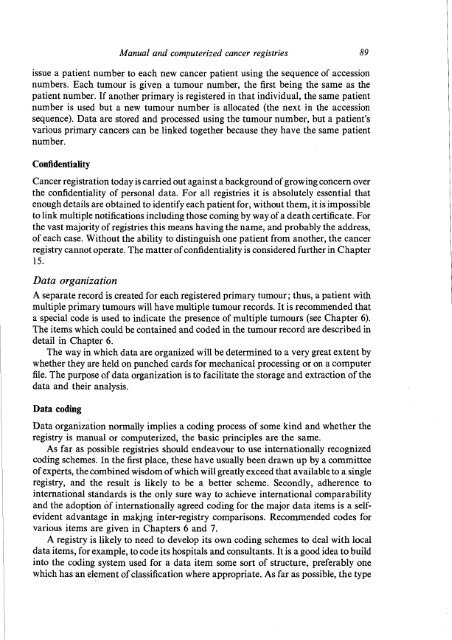Cancer Registration: Principles and Methods - IARC
Cancer Registration: Principles and Methods - IARC
Cancer Registration: Principles and Methods - IARC
Create successful ePaper yourself
Turn your PDF publications into a flip-book with our unique Google optimized e-Paper software.
Manual <strong>and</strong> computerized cancer registries 89<br />
issue a patient number to each new cancer patient using the sequence of accession<br />
numbers. Each tumour is given a tumour number, the first being the same as the<br />
patient number. If another primary is registered in that individual, the same patient<br />
number is used but a new tumour number is allocated (the next in the accession<br />
sequence). Data are stored <strong>and</strong> processed using the tumour number, but a patient's<br />
various primary cancers can be linked together because they have the same patient<br />
number.<br />
Confidentiality<br />
<strong>Cancer</strong> registration today is carried out against a background of growing concern over<br />
the confidentiality of personal data. For all registries it is absolutely essential that<br />
enough details are obtained to identify each patient for, without them, it is impossible<br />
to link multiple notifications including those coming by way of a death certificate. For<br />
the vast majority of registries this means having the name, <strong>and</strong> probably the address,<br />
of each case. Without the ability to distinguish one patient from another, the cancer<br />
registry cannot operate. The matter of confidentiality is considered further in Chapter<br />
15.<br />
Data organization<br />
A separate record is created for each registered primary tumour; thus, a patient with<br />
multiple primary tumours will have multiple tumour records. It is recommended that<br />
a special code is used to indicate the presence of multiple tumours (see Chapter 6).<br />
The items which could be contained <strong>and</strong> coded in the tumour record are described in<br />
detail in Chapter 6.<br />
The way in which data are organized will be determined to a very great extent by<br />
whether they are held on punched cards for mechanical processing or on a computer<br />
file. The purpose of data organization is to facilitate the storage <strong>and</strong> extraction of the<br />
data <strong>and</strong> their analysis.<br />
Data coding<br />
Data organization normally implies a coding process of some kind <strong>and</strong> whether the<br />
registry is manual or computerized, the basic principles are the same.<br />
As far as possible registries should endeavour to use internationally recognized<br />
coding schemes. In the first place, these have usually been drawn up by a committee<br />
of experts, the combined wisdom of which will greatly exceed that available to a single<br />
registry, <strong>and</strong> the result is likely to be a better scheme. Secondly, adherence to<br />
international st<strong>and</strong>ards is the only sure way to achieve international comparability<br />
<strong>and</strong> the adoption of internationally agreed coding for the major data items is a selfevident<br />
advantage in makjng inter-registry comparisons. Recommended codes for<br />
various items are given in Chapters 6 <strong>and</strong> 7.<br />
A registry is likely to need to develop its own coding schemes to deal with local<br />
data items, for example, to code its hospitals <strong>and</strong> consultants. It is a good idea to build<br />
into the coding system used for a data item some sort of structure, preferably one<br />
which has an element of classification where appropriate. As far as possible, the type
















